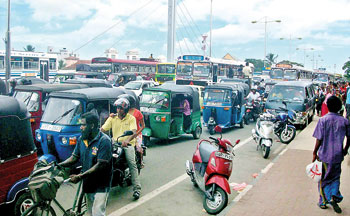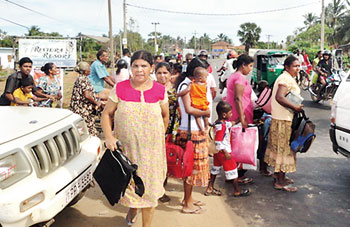Fear and panic reigned in many parts of the country on April 11 (last Wednesday) following a powerful earthquake off Indonesia bringing back a flood of frightening memories of the 2004 December 24 tsunami that ravaged the coastal areas of the country killing tens of thousands.
The 8.6 magnitude earthquake followed by several aftershocks was felt in many parts of Sri Lanka creating panic especially among those in high-rise buildings. Some offices and shops closed and people were seen hitting the roads causing heavy traffic congestion.
There was more mayhem to follow when Sri Lanka officially issued a tsunami warning at 2.15 p.m, after the Pacific Tsunami Warning Centre issued a tsunami bulletin stating a possible tsunami that would hit Dondra Head at 4.09 p.m., Trincomalee at 4.20 p.m., Colombo at 4.50 p.m. and Jaffna at 6.01 p.m.
Despite warnings and evacuation orders being issued a lack of co-ordination and communication among authorities, media and the public created more chaos, said experts in the field of geology, meteorology, information technology and mass communication.
 |
| Traffic jam in Matara town as news spreads about the tsunami alert.
Pix by Krishan Jeewaka Jayaruk |
Peradeniya University’s Professor Emeritus in Geology Kapila Dahanayake said although disaster management officers along with military personnel were involved in the evacuation process in coastal areas, other areas were unprepared to face such a disaster warning.
“People were running amock without proper direction especially in Colombo and other areas where tremors were felt. People were taking routes that always get congested. There were no traffic officers or media directing people through alternate routes to avoid traffic.
He said although it was a good move to open the Southern expressway to the public to avoid plying the coastal roads, shutting down private transport services badly hampered those leaving high risk areas.
Prof. Dahanayake also pointed out that it was unfortunate that many were unaware how to act during an earthquake.
“There were people using elevators while others instead of going to open areas were heading to higher ground like the upper floors of buildings as they were only aware of tsunami preparedness,” he said
Prof. Dahanayake said, those inland should be concerned about earthquakes as they can cause landslides, damage walls of reservoirs and flooding from boulders falling to rivers.
He said although the Eastern and Southern coastal areas were the high risk areas there should also be training in Western and North-western areas as there is a possibility of earthquakes in the ocean South of the country.
While many of the tsunami towers in the coast were activated, several in areas such as Kochchikade in Negombo, Galle Hambantota, Matara, and Thalaimannar failed to react to the communication warnings and did not set off sirens, the Sunday Times learns.
The Disaster Management Ministry said there was technical failure in some instances as the Disaster Management Center (DMC) had shifted to a new building while some of the tsunami towers were still in the test stage.
Meteorology Department former director, K.R.Abeysinghe responding to this said equipment such as electronic communication towers should be inspected regularly. “In countries like Japan, these towers broadcast daily time signals either in the morning or evening as a measure of maintenance and ensure that it would function during an emergency. These are costly but in the long run an efficient investment,” he said.
 |
| Pandemonium: Hitting the road in Batticaloa. Pic by L. Deva Athiren |
He said the Meteorology Department even failed to update its website directing those visiting the site to the United States Geological Survey (USGS) and other international sites. On April 11 the website’s last update showed as October 19, 2010.
“Most people would have naturally assumed that the state weather forecasting body would have the latest update in their site, unfortunately there was none,”he said.
Dr. Chandana Gamage, senior lecturer at Moratuwa University’s Computer Science and Engineering Department said there was a failure in the dissemination of information although technical capability was available.
“Mobile networks were jammed due to heavy flow of repeated alerts and warnings and unwanted calls. The alerts were only limited to warnings while there was little post warning communication. Internet and social media too were not used to the maximum especially by state institutions,” he charged.
Meanwhile Colombo University’s Journalism Unit head Prof. Ajantha Hapuaarachchi said a fear psychosis was created by certain media resulting in panic and severe traffic congestion.
“Some even went to the extent of showing images of the 2004 tsunami and people running along with their belongings. This created unwarranted panic with many even ignoring instructions given by disaster management officials,” she said.
Prof. Hapuaarachchi said it would be far more effective if media worked in coordination with traffic police and directed people to safe places instead of only limiting to evacuation warnings.
Disturbances in the Inter-Tropical Convergence Zone create thunderstorms
Take precautions from lightning strikes, warns Met. Dept.
By Hansani Bandara
Lightning strikes claiming the lives of 20 people in the past one and a half months have focussed the attention of the relevant authorities on the need to enhance awareness among the general public on the hazards of lightning and precautions to be taken to avert future calamities.
The Meteorology Department has issued warnings of showers accompanied by thunder and lightning mainly in the North-central, Eastern, Northern and Uva Provinces.
Met Department Duty Forecaster P. G. Yasaratna said that the main cause for the present weather conditions is the atmospheric disturbances in the Inter-Tropical Convergence Zone (ITCZ) which result in the creation of thunderstorms.
“The ICTZ is the area near the equator where winds from the southern and the northern hemisphere converge. This can create atmospheric disturbances and since Sri Lanka is situated close to the equator, there is an effect of these weather conditions on the country. This is also the period of inter-monsoon conditions in the country, so heavy rain accompanied by thunder and lightning can be expected mostly in the afternoons and nights,” he said.
During the last week four deaths were reported due to lightning strikes where two female tea-pluckers in Pitabeddara were struck while they were taking shelter from the rain in a hut. One of them is a 29-year-old mother of two children. Another incident was reported where a 28-year-old farmer was struck by lightning while he was ploughing a field. He is also the father of two children and the bread winner of the family.
Velupillai Arun Kalam, a 60-year-old also lost his life due to a thunder bolt strike close to his house in Alawatta, Rattota.
The Meteorology Department warns the general public of the conditions that can prevail during the coming weeks and advise them to take necessary precautions to avert the damages caused by lightning strikes.
Mr. Yasaratna further added that people are constantly advised to take precautionary methods to avoid any accidents due to lightning strikes and to refrain from being in open spaces like playgrounds and paddy fields. When a thunder storm occurs they should also desist from touching any metal ware and also unplug all electrical devices in their houses, he said. |



